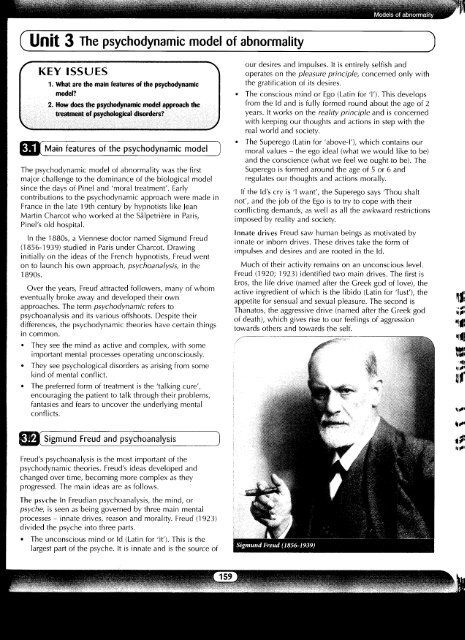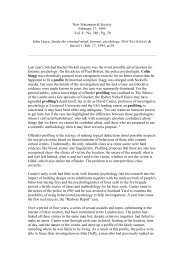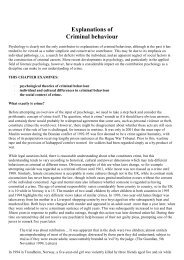Ch 11 - Jeff Standen
Ch 11 - Jeff Standen
Ch 11 - Jeff Standen
Create successful ePaper yourself
Turn your PDF publications into a flip-book with our unique Google optimized e-Paper software.
Models of abnormality<br />
( Unit 3 The psychodynamic model of abnormality<br />
J<br />
KEY ISSUES<br />
1. What are the main features of the psychodynamic<br />
model?<br />
2. How does the psychodynamic model approach the<br />
treatment of psychological disorders?<br />
Main features of the psychodynamic model<br />
The psychodynamic model of abnormality was the first<br />
major challenge to the dominance of the biological model<br />
since the days of Pinel and 'moral treatment'. Early<br />
contributions to the psychodynamic approach were made in<br />
France in the late 19th century by hypnotists like Jean<br />
Martin <strong>Ch</strong>arcot who worked at the Salpetriere in Paris,<br />
Pinel's old hospital.<br />
In the 1880s, a Viennese doctor named Sigmund Freud<br />
(1856-1939) studied in Paris under <strong>Ch</strong>arcot. Drawing<br />
initially on the ideas of the French hypnotists, Freud went<br />
on to launch his own approach, psychoanalysis,<br />
1890s.<br />
in the<br />
Over the years, Freud attracted followers, many of whom<br />
eventually broke away and developed their own<br />
approaches. The term psychodynamic<br />
refers to<br />
psychoanalysis and its various offshoots. Despite their<br />
differences, the psychodynamic theories have certain things<br />
in common.<br />
our desires and impulses. It is entirely selfish and<br />
operates on the pleasure principle, concerned only with<br />
the gratification of its desires.<br />
• The conscious mind or Ego (Latin for 'I'). This develops<br />
from the Id and is fully formed round about the age of 2<br />
years. It works on the reality principle and is concerned<br />
with keeping our thoughts and actions in step with the<br />
real world and society.<br />
• The Superego (Latin for 'above-l'), which contains our<br />
moral values - the ego ideal (what we would like to be)<br />
and the conscience (what we feel we ought to be). The<br />
Superego is formed around the age of 5 or 6 and<br />
regulates our thoughts and actions morally.<br />
If the Id's cry is 'I want', the Superego says 'Thou shalt<br />
not', and the job of the Ego is to try to cope with their<br />
conflicting demands, as well as all the awkward restrictions<br />
imposed by reality and society.<br />
Innate drives Freud saw human beings as motivated by<br />
innate or inborn drives. These drives take the form of<br />
impulses and desires and are rooted in the Id.<br />
Much of their activity remains on an unconscious level.<br />
Freud (1920; 1923) identified two main drives. The first is<br />
Eros, the life drive (named after the Greek god of love), the<br />
active ingredient of which is the libido (Latin for lust'), the<br />
appetite for sensual and sexual pleasure. The second is<br />
Thanatos, the aggressive drive (named after the Greek god<br />
of death), which gives rise to our feelings of aggression<br />
towards others and towards the self.<br />
• They see the mind as active and complex, with some<br />
important mental processes operating unconsciously.<br />
• They see psychological disorders as arising from some<br />
kind of mental conflict.<br />
• The preferred form of treatment is the 'talking cure',<br />
encouraging the patient to talk through their problems,<br />
fantasies and fears to uncover the underlying mental<br />
conflicts.<br />
Qffi Sigmund Freud and psych oanalysis<br />
Freud's psychoanalysis is the most important of the<br />
psychodynamic theories. Freud's ideas developed and<br />
changed over time, becoming more complex as they<br />
progressed. The main ideas are as follows.<br />
The psyche In Freudian psychoanalysis, the mind, or<br />
psyche, is seen as being governed by three main mental<br />
processes - innate drives, reason and morality. Freud (1923)<br />
divided the psyche into three parts.<br />
• The unconscious mind or Id (Latin for 'it'). This is the<br />
largest part of the psyche. It is innate and is the source of<br />
159







